fun 用法详解
funny与fun区别详解

funny与fun的区分一、词性区分funn.娱乐,玩笑,嬉笑,有趣的人或事物vi.开玩笑adj.供娱乐用的funnyadj.有趣的,好笑的,滑稽的,奇异的,古怪的(带有贬义)n.滑稽人物这两个词有程度上的不同,要看你要表达什么样的意思。
说a funny party或a fun story也是可以的。
It's funny.很滑稽的,很有趣的。
It's fun.很好玩。
(从娱乐方面来说)funny还有一些贬义的意思:1.奇特的;难以了解的a funny temper奇特的性格2.失常的;不诚实的There's sth funny about the telephone;it won't work.电话有点反常,打不通。
3.有病的;不舒服的She felt a bit funny.她觉得有点不舒服。
二、两者含义上也有差别:funny表示“有趣的,滑稽的”,它指的是一种滑稽可笑的“有趣”,侧重点是让人觉得好玩或发笑。
fun主要指“有趣,好玩”,不像funny那样强调“滑稽”。
例句:It is more fun to go with someone than to go alone.偕伴同去比自己独自去好玩。
It's funny to see a man walk with his hands and head.看见一个人倒立走路很滑稽词典funn.乐趣,玩笑,娱乐n.[U] Enjoyment, pleasure, or amusement.vi.开玩笑vi. To joke.a.供娱乐用的a. Interested.Eg:I wasn't serious; I only did it for fun.我不是当真的,我只不过是闹着玩。
1Playing basketball is great fun.打篮球很有趣。
I dont see the fun of doing that.我并不觉得那样做有甚么好玩的。
fun、funny详细讲解以及fun做名词、形容词的用法
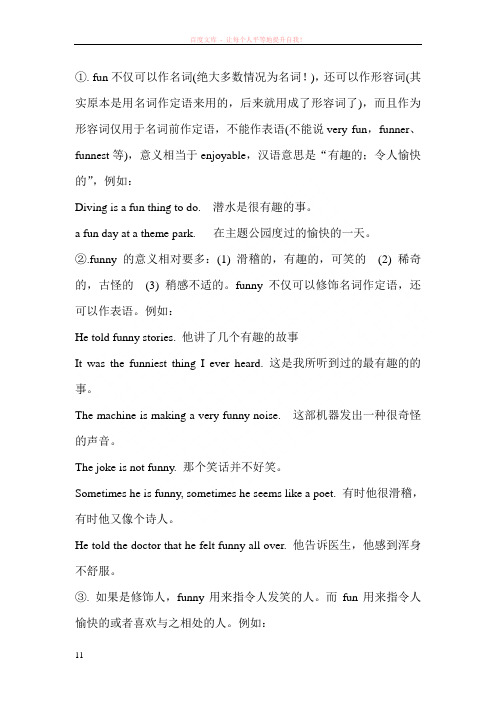
①. fun不仅可以作名词(绝大多数情况为名词!),还可以作形容词(其实原本是用名词作定语来用的,后来就用成了形容词了),而且作为形容词仅用于名词前作定语,不能作表语(不能说very fun,funner、funnest等),意义相当于enjoyable,汉语意思是“有趣的;令人愉快的”,例如:Diving is a fun thing to do. 潜水是很有趣的事。
a fun day at a theme park. 在主题公园度过的愉快的一天。
②.funny的意义相对要多:(1) 滑稽的,有趣的,可笑的(2) 稀奇的,古怪的(3) 稍感不适的。
funny不仅可以修饰名词作定语,还可以作表语。
例如:He told funny stories. 他讲了几个有趣的故事It was the funniest thing I ever heard. 这是我所听到过的最有趣的的事。
The machine is making a very funny noise. 这部机器发出一种很奇怪的声音。
The joke is not funny. 那个笑话并不好笑。
Sometimes he is funny, sometimes he seems like a poet. 有时他很滑稽,有时他又像个诗人。
He told the doctor that he felt funny all over. 他告诉医生,他感到浑身不舒服。
③. 如果是修饰人,funny用来指令人发笑的人。
而fun用来指令人愉快的或者喜欢与之相处的人。
例如:She’s one of the funniest people I know. 她是我所认识的最有意思的人之一。
My sister is a fun person. 我妹妹是一个有趣的人。
fun的用法总结初中

fun的用法总结初中一、fun的定义和作用fun是函数的缩写,表示函数,是编程语言中的一个重要概念。
函数是一段可重复使用的代码块,可以接受输入参数并返回结果。
它可以将代码分解为较小的模块,使得程序更易于理解、维护和扩展。
在编程中,使用函数可以实现以下功能:1. 代码复用:将常用的代码封装成函数,避免重复编写相同代码。
2. 逻辑清晰:将复杂的程序分解为多个小的模块,使得程序结构更加清晰明了。
3. 提高效率:通过调用函数来完成特定任务,能够提高程序运行效率。
二、fun的定义方式在不同编程语言中,定义函数的方式可能有所不同。
下面以Python语言为例介绍几种常见的定义方式。
1. 定义无参无返回值函数def fun():print("Hello World!")2. 定义有参无返回值函数def fun(name):print("Hello " + name + "!")3. 定义无参有返回值函数def fun():return "Hello World!"4. 定义有参有返回值函数def fun(name):return "Hello " + name + "!"三、fun的调用方式在定义好函数之后,需要通过调用来执行它们。
调用函数时需要传递参数,并且根据需要获取函数返回值。
1. 调用无参无返回值函数fun()2. 调用有参无返回值函数fun("Tom")3. 调用无参有返回值函数result = fun()print(result)4. 调用有参有返回值函数result = fun("Tom")print(result)四、fun的参数传递方式在调用函数时,需要根据需要传递参数。
在Python语言中,参数传递方式有以下几种。
1. 位置参数传递def fun(name, age):print(name + " is " + str(age) + " years old.") fun("Tom", 18)2. 关键字参数传递def fun(name, age):print(name + " is " + str(age) + " years old.") fun(age=18, name="Tom")3. 默认参数传递def fun(name, age=18):print(name + " is " + str(age) + " years old.")fun("Tom")fun("Jerry", 20)四、fun的高级应用除了上述基本使用方式之外,函数还可以应用于以下高级场景。
fun的用法

fun的用法fun有乐趣;玩笑等意思,那么你知道fun的用法吗?下面跟着店铺一起来学习一下,希望对大家的学习有所帮助!fun的用法大全:fun的用法1:fun是不可数名词,没有复数形式,也不可加不定冠词,其后可接(in) v -ing。
fun的用法2:fun可用于另一名词前作定语。
fun的用法例句:1. Surfing the Internet is fun, but it's also a time waster.上网很有意思,但也很浪费时间。
2. Under all the innocent fun, there are hidden dangers, especially for children.在所有简单无害的娱乐项目背后都隐藏着危险,特别是对儿童而言。
3. The following recipe is a statement of another kind—food is fun!下面的食谱是另一种观点的表现——食物可以带来乐趣!4. She would have cracked up if she hadn't allowed herself some fun.她若是没给自己找点乐趣的话,早就崩溃了。
5. I hope that everyone will be able to join in the fun.我希望每个人都能够加入进来,玩得开心。
6. He had just come for the fun of it.他来只是为了好玩。
7. There is just not enough fun and frivolity in culture today.当今的文化恰恰是不够轻松有趣。
8. What started out as fun quickly became hard work.起初好玩的事很快就变成了艰苦的工作。
9. Moe was having fun banging the drums and singing off-key.莫自得其乐地一边敲着鼓,一边不成调地唱着歌。
fun 怎么读

fun 怎么读
“Fun”的发音为英式音标/fʌn/,美式音标/fʌn/。
在发音时,注意将舌头放在口腔的中央位置,轻轻地发出“f”的音,然后迅速过渡到“ʌn”的音。
这个词汇的发音相对简单,重点在于保持声带的振动和舌头的正确位置。
“Fun”的基本释义是“乐趣”或“娱乐”,通常用于描述那些能够带来愉悦和享受的活动或事物。
它可以是一个名词,表示有趣的事物或活动,如“having fun”(玩得开心);也可以是一个形容词,表示令人愉快的或有趣的,如“a fun movie”(一部有趣的电影)。
此外,“fun”还可以作为动词使用,表示嬉闹或开玩笑的行为。
在日常生活中,“fun”是一个常用的词汇,用于描述各种令人愉悦的事物或活动。
无论是参加派对、玩游戏、看喜剧电影,还是与朋友一起聊天,都可以说是在享受“fun”。
此外,“fun”还可以用于形容人的性格或行为,表示某人很有趣或善于制造乐趣。
总之,“fun”是一个与愉悦和娱乐紧密相关的词汇,无论是作为名词、形容词还是动词使用,都能为日常交流增添色彩和活力。
通过掌握其正确的发音和多种用法,我们可以更好地理解和运用这个词汇,从而更准确地表达自己的情感和体验。
fun interesting的区别和用法

fun interesting的区别和用法Fun和Interesting是两个常用的英语词汇,它们的意义和用法有些不同。
在日常生活中,我们经常会使用这两个词来形容一些事物或者活动,但是,如果你不了解它们的具体区别和用法,就很容易出现用词不当的情况。
因此,本文将会详细介绍Fun和Interesting的区别和用法,以便大家在使用时更加准确。
一、Fun和Interesting的区别Fun和Interesting都可以用来形容一些事物或者活动,但是它们的意义有所不同。
Fun通常用来形容一些让人感到愉快和有趣的事物或者活动,例如:玩游戏、看电影、和朋友聊天等。
而Interesting 则通常用来形容一些让人感到有趣和吸引人的事物或者活动,例如:读书、旅行、观察动物等。
可以看出,Fun更侧重于“感受”,而Interesting更侧重于“知识”。
此外,Fun和Interesting还有一个区别就是在程度上。
Fun通常表示的是一种强烈的情感体验,例如:非常有趣、非常愉快等。
而Interesting则表示的是一种相对轻微的情感体验,例如:有趣、引人入胜等。
因此,Fun的程度要比Interesting更加强烈。
二、Fun和Interesting的用法1. Fun的用法Fun可以用作形容词或者名词,具体用法如下:(1) 作形容词,表示愉快、有趣的。
例如:- Playing games is always fun. 玩游戏总是很有趣。
- We had a lot of fun at the party. 我们在聚会上玩得很开心。
(2) 作名词,表示娱乐、嬉戏的活动。
例如:- We had a fun afternoon at the amusement park. 我们在游乐园度过了一个愉快的下午。
- Let's have some fun together. 我们一起来玩吧。
2. Interesting的用法Interesting通常用作形容词,表示有趣、引人入胜的。
fun 的用法
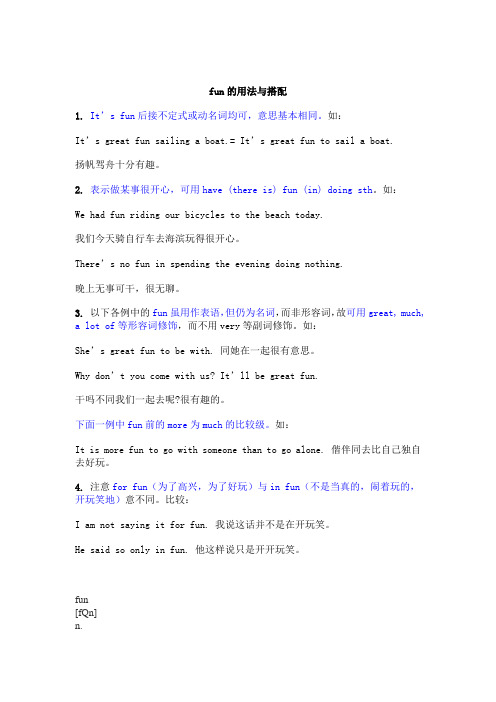
fun的用法与搭配1. It’s fun后接不定式或动名词均可,意思基本相同。
如:It’s great fun sailing a boat.= It’s great fun to sail a boat.扬帆驾舟十分有趣。
2. 表示做某事很开心,可用have (there is) fun (in) doing sth。
如:We had fun riding our bicycles to the beach today.我们今天骑自行车去海滨玩得很开心。
There’s no fun i n spending the evening doing nothing.晚上无事可干,很无聊。
3. 以下各例中的fun虽用作表语,但仍为名词,而非形容词,故可用great, much,a lot of等形容词修饰,而不用very等副词修饰。
如:She’s great fun to be with. 同她在一起很有意思。
Why don’t you come with us? It’ll be great fun.干吗不同我们一起去呢?很有趣的。
下面一例中fun前的more为much的比较级。
如:It is more fun to go with someone than to go alone. 偕伴同去比自己独自去好玩。
4.注意for fun(为了高兴,为了好玩)与in fun(不是当真的,闹着玩的,开玩笑地)意不同。
比较:I am not saying it for fun. 我说这话并不是在开玩笑。
He said so only in fun. 他这样说只是开开玩笑。
fun[fQn]n.娱乐, 玩笑, 嬉笑, 有趣的人或事物vi.开玩笑adj.供娱乐用的fun[fQn]n.嬉戏;顽皮The little dog's full of fun. 这小狗很顽皮。
娱乐;乐趣Have fun at the party tonight. 今晚的晚会上玩得很开心。
fun的词语
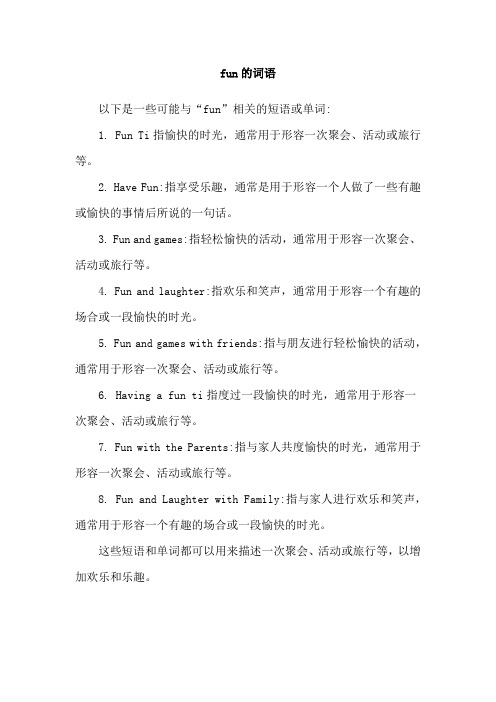
fun的词语
以下是一些可能与“fun”相关的短语或单词:
1. Fun Ti指愉快的时光,通常用于形容一次聚会、活动或旅行等。
2. Have Fun:指享受乐趣,通常是用于形容一个人做了一些有趣或愉快的事情后所说的一句话。
3. Fun and games:指轻松愉快的活动,通常用于形容一次聚会、活动或旅行等。
4. Fun and laughter:指欢乐和笑声,通常用于形容一个有趣的场合或一段愉快的时光。
5. Fun and games with friends:指与朋友进行轻松愉快的活动,通常用于形容一次聚会、活动或旅行等。
6. Having a fun ti指度过一段愉快的时光,通常用于形容一次聚会、活动或旅行等。
7. Fun with the Parents:指与家人共度愉快的时光,通常用于形容一次聚会、活动或旅行等。
8. Fun and Laughter with Family:指与家人进行欢乐和笑声,通常用于形容一个有趣的场合或一段愉快的时光。
这些短语和单词都可以用来描述一次聚会、活动或旅行等,以增加欢乐和乐趣。
Fun同funny的区别
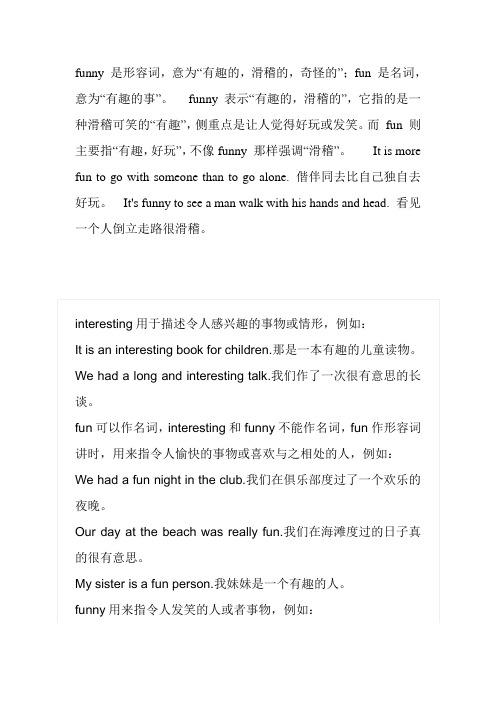
funny 是形容词,意为“有趣的,滑稽的,奇怪的”;fun 是名词,意为“有趣的事”。
funny 表示“有趣的,滑稽的”,它指的是一种滑稽可笑的“有趣”,侧重点是让人觉得好玩或发笑。
而fun 则主要指“有趣,好玩”,不像funny 那样强调“滑稽”。
It is more fun to go with someone than to go alone. 偕伴同去比自己独自去好玩。
It's funny to see a man walk with his hands and head. 看见一个人倒立走路很滑稽。
interesting用于描述令人感兴趣的事物或情形,例如:It is an interesting book for children.那是一本有趣的儿童读物。
We had a long and interesting talk.我们作了一次很有意思的长谈。
fun可以作名词,interesting和funny不能作名词,fun作形容词讲时,用来指令人愉快的事物或喜欢与之相处的人,例如:We had a fun night in the club.我们在俱乐部度过了一个欢乐的夜晚。
Our day at the beach was really fun.我们在海滩度过的日子真的很有意思。
My sister is a fun person.我妹妹是一个有趣的人。
funny用来指令人发笑的人或者事物,例如:That's the funniest joke I've ever heard.那是我所听过的最风趣的笑话。
joyful指“一种外来事件使情绪强烈、起劲、愉快的”, 如: They were singing and dancing to celebrate this joyful occasion. 他们唱着、跳着庆祝这令人欢乐的时刻。
joyous 指“性情或气质上快乐的”, 如: a joyous family 快乐的家庭。
感叹句中fun的用法
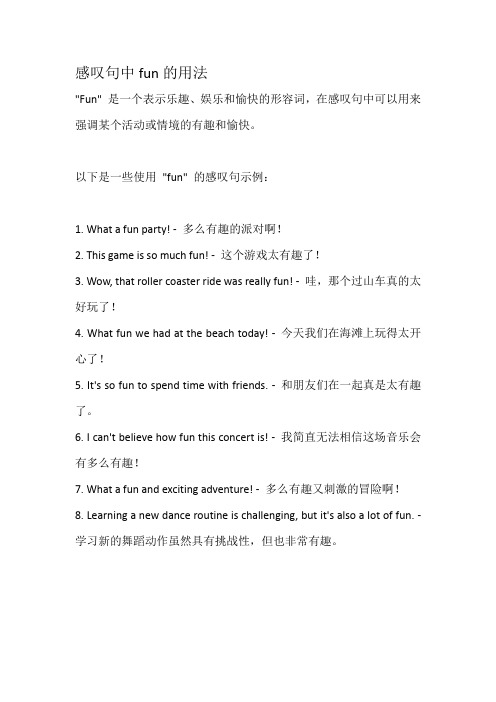
感叹句中fun的用法
"Fun" 是一个表示乐趣、娱乐和愉快的形容词,在感叹句中可以用来强调某个活动或情境的有趣和愉快。
以下是一些使用"fun" 的感叹句示例:
1. What a fun party! -多么有趣的派对啊!
2. This game is so much fun! -这个游戏太有趣了!
3. Wow, that roller coaster ride was really fun! -哇,那个过山车真的太好玩了!
4. What fun we had at the beach today! -今天我们在海滩上玩得太开心了!
5. It's so fun to spend time with friends. -和朋友们在一起真是太有趣了。
6. I can't believe how fun this concert is! -我简直无法相信这场音乐会有多么有趣!
7. What a fun and exciting adventure! -多么有趣又刺激的冒险啊!
8. Learning a new dance routine is challenging, but it's also a lot of fun. -学习新的舞蹈动作虽然具有挑战性,但也非常有趣。
fun-用法详解
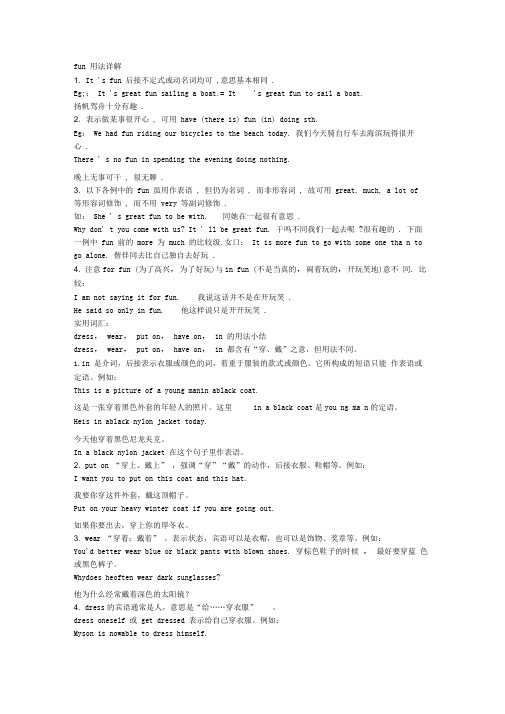
fun 用法详解1. It 's fun 后接不定式或动名词均可 ,意思基本相同 .Eg;: It 's great fun sailing a boat.= It 's great fun to sail a boat.扬帆驾舟十分有趣 .2. 表示做某事很开心 , 可用 have (there is) fun (in) doing sth.Eg: We had fun riding our bicycles to the beach today. 我们今天骑自行车去海滨玩得很开心 .There ' s no fun in spending the evening doing nothing.晚上无事可干 , 很无聊 .3. 以下各例中的 fun 虽用作表语 , 但仍为名词 , 而非形容词 , 故可用 great, much, a lot of 等形容词修饰 , 而不用 very 等副词修饰 .如: She ' s great fun to be with. 同她在一起很有意思 .Why don' t you come with us? It ' ll be great fun. 干吗不同我们一起去呢 ?很有趣的 . 下面一例中 fun 前的 more 为 much 的比较级.女口: It is more fun to go with some one tha n to go alone. 偕伴同去比自己独自去好玩 .4. 注意for fun (为了高兴,为了好玩)与in fun (不是当真的,闹着玩的,开玩笑地)意不同. 比较:I am not saying it for fun. 我说这话并不是在开玩笑 .He said so only in fun. 他这样说只是开开玩笑 .实用词汇:dress, wear, put on, have on, in 的用法小结dress, wear, put on, have on, in 都含有“穿、戴”之意,但用法不同。
形容人有趣是fun还是funny

形容人有趣是fun还是funny
如果是修饰人,funny用来指令人发笑的人。
而fun用来指令人愉快的或者喜欢与之相处的人。
fun作为形容词仅用于名词前作定语,不能作表语,意义相当于enjoyable,汉语意思是“有趣的;令人愉快的”。
funny不仅可以修饰名词作定语,还可以作表语。
funny例句
It shows that your child can now see the funny side of things 这表明你的孩子现在可以领会事情有趣的一面了。
I'll tell you a funny story.
我来给你讲一个有趣的故事。
It's good you can see the funny side of the situation.
你能看到情况可笑的一面,这很好。
It's not funny! Someone could have been hurt.
这没什么好玩的!可能有人会受到伤害。
I suspect there may be something funny going on.
我怀疑可能有某种非法勾当在进行中。
fun函数的用法

fun函数的用法Python中的fun函数是一个非常有用的函数,它可以用来定义一个函数,这个函数可以接受任意数量的参数,并且可以返回任意类型的值。
在本文中,我们将详细介绍fun函数的用法,包括如何定义函数、如何传递参数、如何返回值等。
一、定义函数在Python中,我们可以使用fun函数来定义一个函数。
fun函数的语法如下:```def fun(*args, **kwargs):# 函数体```其中,args表示任意数量的位置参数,kwargs表示任意数量的关键字参数。
在函数体中,我们可以使用这些参数来完成我们想要的操作。
例如,下面的代码定义了一个函数,它可以接受任意数量的位置参数,并将它们相加:```def add(*args):result = 0for arg in args:result += argreturn result```二、传递参数在调用函数时,我们可以传递任意数量的位置参数和关键字参数。
例如,下面的代码调用了上面定义的add函数,并传递了三个位置参数:```result = add(1, 2, 3)print(result) # 输出6```我们也可以传递任意数量的关键字参数。
例如,下面的代码定义了一个函数,它可以接受任意数量的关键字参数,并将它们合并成一个字典:def merge(**kwargs):result = {}for key, value in kwargs.items():result[key] = valuereturn result```我们可以通过传递关键字参数来调用这个函数。
例如,下面的代码调用了上面定义的merge函数,并传递了两个关键字参数:```result = merge(a=1, b=2)print(result) # 输出{'a': 1, 'b': 2}```我们也可以同时传递位置参数和关键字参数。
例如,下面的代码调用了上面定义的add函数,并传递了两个位置参数和一个关键字参数:```result = add(1, 2, c=3)print(result) # 输出3```三、返回值在函数体中,我们可以使用return语句来返回一个值。
fun和interesting的用法区别
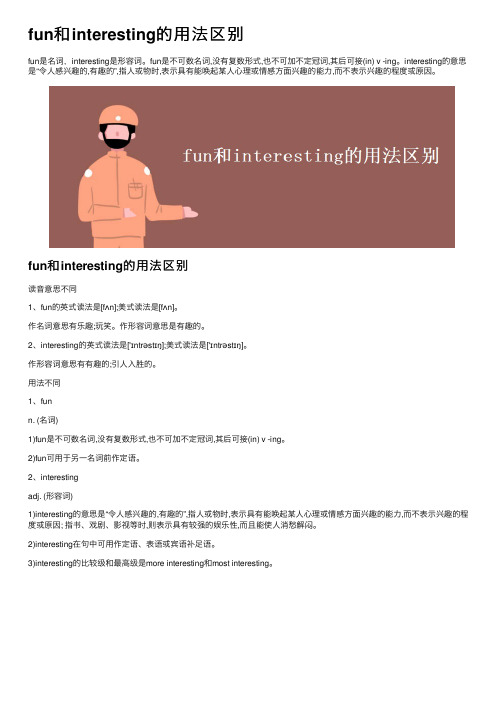
fun和interesting的⽤法区别
fun是名词,interesting是形容词。
fun是不可数名词,没有复数形式,也不可加不定冠词,其后可接(in) v -ing。
interesting的意思是“令⼈感兴趣的,有趣的”,指⼈或物时,表⽰具有能唤起某⼈⼼理或情感⽅⾯兴趣的能⼒,⽽不表⽰兴趣的程度或原因。
fun和interesting的⽤法区别
读⾳意思不同
1、fun的英式读法是[fʌn];美式读法是[fʌn]。
作名词意思有乐趣;玩笑。
作形容词意思是有趣的。
2、interesting的英式读法是['ɪntrəstɪŋ];美式读法是['ɪntrəstɪŋ]。
作形容词意思有有趣的;引⼈⼊胜的。
⽤法不同
1、fun
n. (名词)
1)fun是不可数名词,没有复数形式,也不可加不定冠词,其后可接(in) v -ing。
2)fun可⽤于另⼀名词前作定语。
2、interesting
adj. (形容词)
1)interesting的意思是“令⼈感兴趣的,有趣的”,指⼈或物时,表⽰具有能唤起某⼈⼼理或情感⽅⾯兴趣的能⼒,⽽不表⽰兴趣的程度或原因; 指书、戏剧、影视等时,则表⽰具有较强的娱乐性,⽽且能使⼈消愁解闷。
2)interesting在句中可⽤作定语、表语或宾语补⾜语。
3)interesting的⽐较级和最⾼级是more interesting和most interesting。
fun的用法总结

fun的用法总结
1. fun可以作为形容词使用,表示有趣、愉快的,常用于描述活动、娱乐等。
例如:I had a fun weekend.(我度过了一个愉快的周末。
)
2. fun也可以作为名词使用,表示娱乐、乐趣。
例如:We had
a lot of fun at the party.(我们在派对上玩得很开心。
)
3. fun还可以用作动词,表示玩耍、寻求乐趣。
例如:We were just funning with you.(我们只是和你开玩笑。
)
4. fun还可以用作性格特点或风格的修饰词,表示有趣的、活泼的。
例如:She has a fun personality.(她个性有趣。
)
5. fun可以与动词结合使用,表示某人感到愉快。
例如:I had fun playing soccer.(我踢足球很开心。
)
总结起来,fun是一个多功能的词,可以作为形容词、名词和动词使用,表示有趣、愉快、娱乐等概念。
fun的用法总结初中

任务名称:fun的用法总结初中一、引言初中是每个人成长的重要阶段,是一个充满趣味与挑战的时期。
在这个阶段,fun (有趣的事物或活动)在学习和生活中起着重要作用。
本文将深入探讨fun的用法在初中阶段的各个方面的作用。
二、fun的用法在学习中的作用2.1 提高学习效率•制造有趣的学习环境,例如利用游戏和竞赛激励学习兴趣。
•利用趣味的教学方法,如趣味性的实验和模型,吸引学生对知识的兴趣和好奇心。
2.2 促进知识的理解和记忆•利用有趣的绘图、漫画或故事来帮助学生理解抽象概念。
•利用口头游戏和小组竞赛形式巩固知识。
三、fun的用法在课余活动中的作用3.1 促进团队合作•进行团队游戏和项目,帮助学生培养合作意识和团队精神。
•利用游戏和竞赛活动,加强学生之间的合作与沟通能力。
3.2 拓展兴趣和爱好•提供丰富多样的课外活动,让学生自由选择并发展自己的兴趣和特长。
•组织社团活动,如音乐、绘画、舞蹈等,为学生提供展示和交流的平台。
3.3 释放学生的压力•定期组织娱乐活动,如校园晚会、运动会等,让学生能够尽情放松和享受快乐时光。
•提供个性化的课余辅导,帮助学生解决学习压力和困惑。
四、fun的用法在人际关系中的作用4.1 帮助建立友谊•通过学校组织的集体活动,学生可以结识新朋友,拓展社交圈子。
•利用有趣的交流和合作活动,加强同学之间的友谊和互动。
4.2 提升交流能力•培养学生善于表达和沟通的能力,通过角色扮演、辩论等形式锻炼学生的口头表达能力。
•通过游戏和竞赛活动,培养学生良好的团队合作和协调能力。
4.3 培养责任心和同理心•通过参与义工活动和社区服务项目,学生能够体验到乐于助人的快乐,培养责任心和同理心。
•利用趣味的小组活动,让学生了解和欣赏不同人的优点和特色,培养尊重和包容的态度。
五、fun的用法在个人发展中的作用5.1 培养创新思维•提供创意活动,鼓励学生放松大胆地提出新点子。
•利用科技和艺术结合的活动,提升学生的创造力和实践动手能力。
fun是可数还是不可数
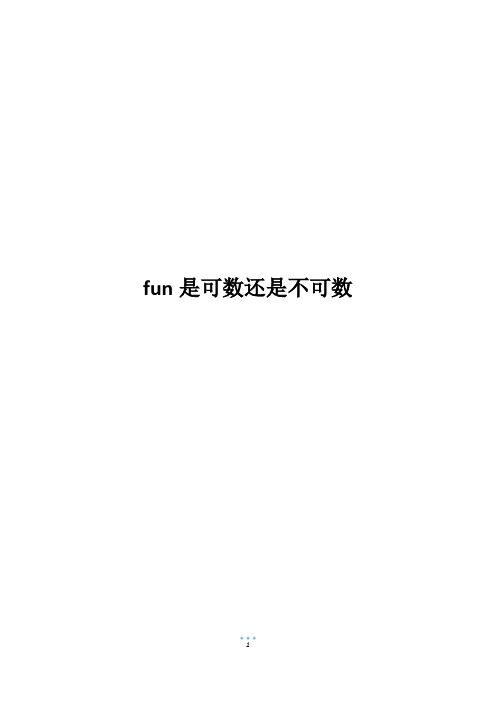
fun是可数还是不可数
fun是不可数名词。
fun作名词意为:享乐;乐趣;快乐;享乐的事;嬉戏;逗乐;玩笑。
作形容词意为:逗乐的;有趣的;使人快乐的。
作不及物动词意为:开玩笑。
一、fun发音
英[fʌn]
美[fʌn]
二、fun单词释义
n.享乐;乐趣;快乐;享乐的事;嬉戏;逗乐;玩笑
adj.逗乐的;有趣的;使人快乐的
vi.嬉闹;开玩笑
三、词性转换
第三人称单数:funs
现在分词:funning
过去式:funned
过去分词:funned
四、双语例句
1.We've had a lot of fun over the years.
这些年来我们过得很开心。
2.He thinks it's clever to make fun of people.
他觉得拿别人开玩笑显得聪明。
3.Her life is one long round of parties and fun.
她的生活就是没完没了的聚会娱乐。
4.The entertainment was good clean fun for the whole family. 这种娱乐文明有趣,对全家老少都适合。
5.It wasn't serious ─ it was all done in fun.那不是认真的,全是闹着玩的。
6.She's really fun to be with.
和她在一起真开心。
Starter Unit 3(学生版)

七年级上册英语Starter Unit 3知识点与语法精讲精练1. What is fun in a yard? 庭院里有什么好玩的? 【用法详解】►I hope you’ll have fun (= have a good time/enjoy yourselves )at the party. 我希望你们在聚会上玩得开心。
►We have fun playing games in class. 我们在课堂上做游戏很开心。
►It’s really a fun day! 真是有趣的一天!(作定语) ►This game looks fun ! 这个游戏看起来很好玩!(作表语) 【即学即用】( )1.Jane is having fun ________ games with her parents on the farm.A. playB. playingC. to playD. plays2. ①—What’s that? 那是什么? —It’s a cat. 那是一只猫。
②—What are these? 这些是什么?—They’re carrot plants. 这些是胡萝卜植株。
【用法详解】知识点1: 重点:“What + be +指示代词?”该句型用来询问“某物是什么”,其答语为“It’s/They’re ...”.数指示代词意义 单数这;这个 那;那个 复数这些那些知识点梳理Section A What is fun in a yard?在句中可作定语或表语【不可数名词】乐趣;快乐玩得开心;过得愉快have fun doing sth.做某事很开心 【形容词】有趣的;使人快乐的 fun指近处指远处(1)指示代词后面所接的谓语:this / that 后面接谓语 (单数/复数)形式;these/ those 后面接谓语 (单数/复数)形式。
如:This / That is a chair. 这/ 那是一张椅子。
- 1、下载文档前请自行甄别文档内容的完整性,平台不提供额外的编辑、内容补充、找答案等附加服务。
- 2、"仅部分预览"的文档,不可在线预览部分如存在完整性等问题,可反馈申请退款(可完整预览的文档不适用该条件!)。
- 3、如文档侵犯您的权益,请联系客服反馈,我们会尽快为您处理(人工客服工作时间:9:00-18:30)。
fun 用法详解1. It’s fun后接不定式或动名词均可,意思基本相同.Eg;:It’s great fun sailing a boat.= It’s great fun to sail a boat.扬帆驾舟十分有趣.2. 表示做某事很开心,可用have (there is) fun (in) doing sth.Eg:We had fun riding our bicycles to the beach today.我们今天骑自行车去海滨玩得很开心.There’s no fun in spending the evening doing nothing.晚上无事可干,很无聊.3. 以下各例中的fun虽用作表语,但仍为名词,而非形容词,故可用great, much, a lot of等形容词修饰,而不用very等副词修饰.如:She’s great fun to be with. 同她在一起很有意思.Why don’t you come with us? It’ll be great fun. 干吗不同我们一起去呢?很有趣的.下面一例中fun前的more为much的比较级.如:It is more fun to go with someone than to go alone. 偕伴同去比自己独自去好玩.4. 注意for fun(为了高兴,为了好玩)与in fun(不是当真的,闹着玩的,开玩笑地)意不同.比较:I am not saying it for fun. 我说这话并不是在开玩笑.He said so only in fun. 他这样说只是开开玩笑.实用词汇:dress, wear, put on, have on, in的用法小结dress, wear, put on, have on, in 都含有“穿、戴”之意,但用法不同。
1.in是介词,后接表示衣服或颜色的词,着重于服装的款式或颜色。
它所构成的短语只能作表语或定语。
例如:This is a picture of a young man in a black coat.这是一张穿着黑色外套的年轻人的照片。
这里in a black coat是young man的定语。
He is in a black nylon jacket today.今天他穿着黑色尼龙夹克。
In a black nylon jacket在这个句子里作表语。
2.put on “穿上、戴上”,强调“穿”“戴”的动作,后接衣服、鞋帽等。
例如:I want you to put on this coat and this hat.我要你穿这件外套,戴这顶帽子。
Put on your heavy winter coat if you are going out.如果你要出去,穿上你的厚冬衣。
3.wear “穿着;戴着”,表示状态,宾语可以是衣帽,也可以是饰物、奖章等。
例如:You’d better wear blue or black pants with blown shoes. 穿棕色鞋子的时候, 最好要穿蓝色或黑色裤子。
Why does he often wear dark sunglasses?他为什么经常戴着深色的太阳镜?4.dress的宾语通常是人,意思是“给……穿衣服”。
dress oneself 或 get dressed表示给自己穿衣服。
例如:My son is now able to dress himself.我儿子现在自己会穿衣服了。
It’s time to wake up and get dressed!该起床穿衣服了。
be dressed in 的意思是“穿着”,表示状态。
She is dressed in a fur coat. 她穿着毛皮大衣。
5.dress up的意思是“盛装打扮、乔装打扮”。
I’d like you to dress up for my birthday party tonight.今晚我希望你为我的生日派对打扮打扮。
Young kids often dress up and have fun at Halloween.万圣节前夜,小孩子通常都乔装打扮,玩得很开心。
6.have on的意思是“穿着,戴着”,例如:If you're wearing black pants you should have on black shoes and a black belt.如果你穿着黑色长裤的话,你应该要穿黑色的鞋子,配黑色的皮带。
I’ll have on black pants and a gray shirt tomorrow.明天我会穿一条黑色的长裤和一件灰色的衬衫。
spend,cost,take和payspend,cost,take和pay的区别是历年考试的必考内容之一,虽然它们都可以表示"花费",但用法却不尽相同,讲解如下:spend的主语必须是人,常用于以下结构:(1) spend time /money on sth. 在……上花费时间(金钱)。
例:I spent two hours on this maths problem. 这道数学题花了我两个小时。
(2) spend time /money (in) doing sth. 花费时间(金钱)做某事。
例:They spent two years (in) building this bridge. 造这座桥花了他们两年时间。
(3)spend money for sth. 花钱买……。
例:His money was spent for books. 他的钱用来买书了。
cost的主语是物或某种活动,还可以表示"值",常见用法如下:(1)sth. costs (sb.) +金钱,某物花了(某人)多少钱。
例:A new computer costs a lot of money. 买一台新电脑要花一大笔钱。
(2) (doing) sth. costs (sb.) +时间,某物(做某事)花了(某人)多少时间。
例:Remembering these new words cost him a lot of time.他花了大量时间才记住了这些单词。
注意:cost的过去式及过去分词都是cost,并且不能用于被动句。
take后面常跟双宾语,常见用法有以下几种:(1) It takes sb. +时间+to do sth. 做某事花了某人多少时间。
例:It took them three years to build this road. 他们用了三年时间修完了这条路。
(2)doing sth. takes sb. +时间,做某事花了某人多少时间。
例:Repairing this car took him the whole afternoon. 他花了一下午修车。
pay的基本用法是:(1) pay (sb.) money for sth. 付钱(给某人)买……。
例:I have to pay them 20 pounds for this room each month.我每个月要付20英磅的房租。
(2)pay for sth. 付……的钱。
例:I have to pay for the book lost. 我不得不赔丢失的书款。
(3)pay for sb. 替某人付钱。
例:Don‘t worry! I'll pay for you. 别担心,我会给你付钱的。
(4)pay sb. 付钱给某人。
例: They pay us every month.他们每月给我们报酬。
(5)pay money back 还钱。
例:May I borrow 12 yuan from you? I'll pay it back next week. 你能借给我12块钱吗?下周还你。
(6)pay off one's money还清钱。
【一讲一练】1. I'm interested in animals, so I ___every Saturday working in an animal hospitalA. PayB. costC. takeD. spend [答案]D [解析]该题考查的是pay, cost, take, spend这四个动词的用法区别。
只有动词spend已经用在Sb spends time (in)doing sth这个句型中,因此选D.2. They spend too much time the report(报道).A. writingB. to writeC. on writingD. write[答案]A3. --What beautiful shoes you’re wearing! They must be expensive(贵).--No,they only____l0 Yuan.A.spent B.took C.paid D.cost[答案]D4. --Will you please for my dinner Peter?--Sure!A. spendB. payC. costD. take[答案]B5. It will me too much time to read this book.A. takeB. costC. spendD. pay[答案]A6. This science book __ me a great amount of money.A. tookB. cost C used D. spent[答案]B7.-Do you often get online?-Yes, I ____ lots of time on it. It’s a good way to kill time.A. costB. spend C .take D. pay[答案]B。
